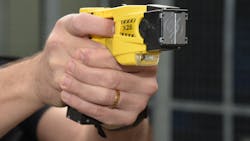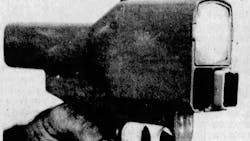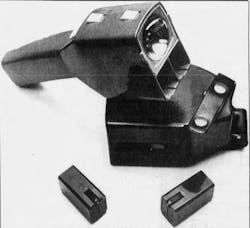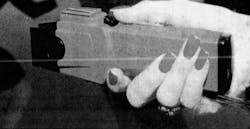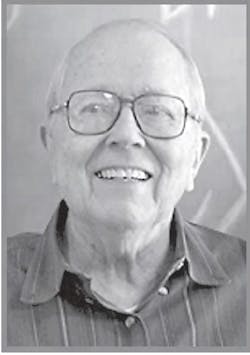History of the TASER: How It Became an Essential Police Tool
The TASER has become one of the most popular less-lethal options for law enforcement. According to Reuters, they are used by more than 90% of the roughly 18,000 law enforcement agencies in the U.S. Civilian demand for the weapon increased by 300% in 2020 compared to the previous year, mostly driven by social unrest and rising violent crime rates. That contributed to the largest TASER contract in history—a $20 million deal with an undisclosed customer. But as popular as the TASER has become, it is hard to imagine that it was mostly rejected by law enforcement. The TASER originally began as one man’s invention created in a garage. The company was on the verge of bankruptcy until two brothers turned it into a multi-million dollar industry.
Less-lethal weapons were born out of the turbulent 1960s from the anti-war protests on the college campus in Berkeley, California, law enforcement clashes with protesters in Chicago at the 1968 Democratic National Convention to the Kent State Massacre that left four dead and nine wounded. These events demonstrated the need for law enforcement to have other options available besides firearms. Although chemical mace had been invented during the 1960s, it had limitations. It required close contact to be effective, officers would inevitably be affected by the spray, and it may not be effective on those under the influence of drugs.During the 1960s, a new weapon was being developed that would immobilize but not kill a person. This new weapon was the TASER, invented by Jack Cover. Growing up in Chicago, he received his doctorate in physics from the University of Chicago. He trained as a nuclear physicist studying under Enrico Fermi, who created the first nuclear reactor and Edward Teller, “father of the hydrogen bomb.” During WWII, he served as an Army test pilot before becoming a NASA aerospace engineer where he assisted on the Apollo moon landing program. In his spare time, he was an avid inventor creating voice-activated switches, cooked food testers, and an electric toothbrush. But the TASER is what he will most be remembered for.
Cover came up with the idea for the weapon due to the increasing number of airline hijackings. Although armed officers were on board the flights, firing a bullet inside a plane could have disastrous consequences if it impacted the fuselage. He began working in his garage on a weapon to solve that problem. The result was a weapon that would fire electrically charged darts at a subject.In 1970, he created TASER Systems, Inc. headquartered in City of Industry, California. The name TASER is an acronym derived from one of his favorite childhood books, “Tom Swift and his Electric Rifle.” The "A" was added for easier pronunciation. The 1911 story chronicles the adventures of Tom Swift and his rifle that shoots bolts of electricity.
After he acquired the patent, the TASER went into production with the hopes that it would be used by the airlines. However, when the airlines opted to go with searches and metal detectors, he turned his focus towards law enforcement as the first alternative to the gun. TASER unveiled their first weapon, named the “Public Defender” in March 1975 at a cost of $200.
Shaped like a flashlight, there were two compartments below the light that contained darts attached to 15 feet of wire. The device was only nine inches long and weighed one pound and was powered by batteries. A trigger activates the gunpowder inside the compartment that was needed to propel the darts. As the darts made impact, they transferred 50,000 volts of electricity immobilizing the subject. The TASER was designed to allow the operator to pull the trigger repeatedly, sending another “zap” into the body.The TASER was promoted as “the first effective means of defense that does not destroy living tissue or vital organs.” There was very little muzzle velocity and it was compared to being hit with a Ping Pong ball. The company pointed out that there was a chance that the electricity could injure someone with a pacemaker or who suffers from heart disease, but there is “no weapon, technique, or procedure for subduing attackers or restraining crowds that does not involve some risk of injury.”
While the company had put together a great marketing program, it was met with much criticism. Doctors testified that the TASER posed major hazards to those suffering from heart related issues. It was for this reason that law enforcement mostly rejected it. After a brief trial period, a lieutenant from Akron, OH called the TASER “a horrible device that should be banned from the marketplace.” However, some departments like Nashville praised it as an effective police weapon.
While the TASER was originally targeted for law enforcement, only ten out of the first 1,000 units went to police departments. A majority of the sales were to private citizens and it wasn’t long before criminals began to use the TASER during the commission of crimes. The first reported incident was in Miami when a TASER was used on a gas station clerk during a robbery. The TASER was traced back to a robbery of a gun store two weeks earlier in which nine TASERs were stolen. Another incident occurred when four robbers used a TASER to torture a couple in Blue Bell, PA. The problem with the TASER was that it was unregulated and could be bought through mail order ads in magazines and through unlicensed dealers.
The TASER came under scrutiny by the federal and state governments. The TASER was being demonstrated at the International Security Conference in New York when the NYPD shut it down because the weapon was deemed a firearm and it required a permit under state law. Because the TASER used gunpowder to propel the darts, the ATF was able to classify it as a “Title II” weapon, putting it in the same category as tommy guns, bombs, and silencers. In 1977, after some modifications, it was reclassified as an ordinary firearm. This allowed more registered gun owners to purchase them, but the government still retained the power to regulate its use.
States began to pass legislation banning the sale, possession, and manufacture of stun guns. With the restrictions by the federal and state governments, the company was losing money. They decided to change their focus audience from law enforcement to the general public. The TASER was given a new name, the TF76.
The company was headed towards bankruptcy in 1980 when the LAPD gave it a much needed shot in the arm. LAPD had rejected the TASER twice during the 1970’s but an officer involved shooting in 1979 made the department take a third look. Eula Love, a 39 year old widow in south central Los Angeles, was shot eight times by two officers. They originally responded to a dispute between her and a gas company representative over an unpaid bill of $22. The officers claimed that she “menaced” them with a knife before they opened fire. Although the officers were cleared of any wrongdoing, the department began to explore other less lethal options.
The LAPD became the largest police agency to use the TASER and it was reported that it was used on average 2 to 3 times a day. While more police agencies began to use the TASER, it was still not at the level that Cover had envisioned. Civilian sales were hampered by strict state and federal regulations. But in the early 1990’s, two brothers from Arizona would change all of that and turn Cover’s company into a multi-million dollar publicly owned company.
In 1990, Rick and Tom Smith bought their mother a gun for her birthday, but they began to wonder if there was a better alternative than a deadly weapon. They came up with the idea to revolutionize the TASER so they bought the company and patent owned by Jack Cover. They subsequently employed Cover in their new company, AIR TASER, Inc. based in Scottsdale, AZ.
The company’s first weapon, the Air TASER, was designed to address the problems that hindered the original TASER invented by Cover. Instead of using gunpowder, the Air TASER used compressed air. This was a major change because the TASER was no longer considered a firearm and therefore was free from regulation. The Air TASER also addressed the issue of criminal use by implementing “anti-felon” dots. When the TASER is deployed, small paper dots are ejected which contain the weapon’s serial number that can be traced back to the seller and buyer.
The company began to experiment with other devices such as the Auto TASER. An auto theft device that resembled The Club, it attaches to the steering wheel. The device emits a five second alarm when it detects that someone has entered the vehicle. After the alarm sounds, a jolt of electricity is administered to anyone that lingers near the steering wheel. It was endorsed by the National Fraternal Order of Police. But it also came with plenty of criticism, as one attorney remarked, “This is by far the most egregious example...of a product that allows people to take the law into their own hands.”
In 1999, the company was renamed TASER International. It also debuted a new model, the M26 TASER. This model was designed to resemble more of a handgun than a flashlight. It still maintained the 50,000 voltage but only for five seconds. Along with the “anti-felon” dots, it had an internal tracking device that kept track of the number of times the trigger was pulled. It had a button trigger instead of a firearm trigger and it came with yellow striping to distinguish it from a firearm and was equipped with laser sights. The TASER probes were extended to 21 feet from 15 feet. There were two versions, one for law enforcement and the other for the general public.
In 2004, the X26 debuted which was lighter and 60% smaller than the M26. It came with a unique feature that records the date, time, and duration of the shock. This was added to protect the officer from false allegations. The company continues to design new products such as the X2, a two shot TASER which eliminates the need to reload, or their newest weapon and most effective, the TASER 7.
TASER International became a publicly traded company in 2001. The company expanded into the body camera market in 2008. With that success, the company renamed itself Axon in 2017.
Jack Cover died in 2009 at the age of 88 from Alzheimer’s disease but he will forever be remembered for his innovative invention that forever changed law enforcement.
About the Author

Robert Bowling
Robert Bowling is a retired police officer from Fishers (IN) and Durham (NC) police departments. In retirement, he has continued his passion to honor fallen officers. He is an Ambassador for the National Law Enforcement Memorial, as well as an historical researcher for the Officer Down Memorial Page. He also has a passion for history, focusing primarily on law enforcement history. He is a member of the Police History Society and is the author of the book Wicked Fishers. He currently teaches Criminal Justice for a local high school.
